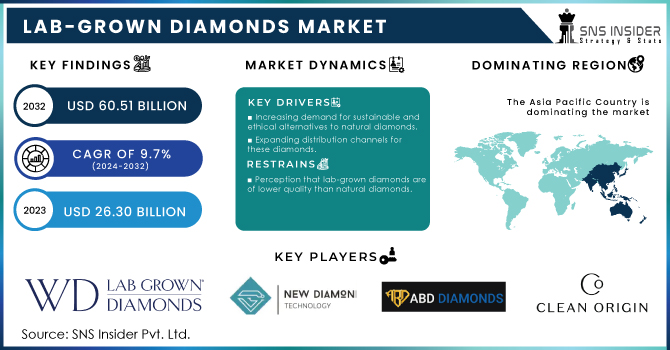Lab-grown diamonds are transforming the diamond industry by offering a sustainable and cost-effective alternative to natural diamonds. Created using advanced technology, these diamonds share the same physical and chemical properties as their mined counterparts. This article explores the technology behind lab-grown diamonds, their benefits, and current market trends. The Lab-Grown Diamonds Market was valued at USD 26.30 billion in 2023 and is projected to reach USD 60.51 billion by 2032, growing at a CAGR of 9.7% during the forecast period from 2024 to 2032.
Technology Behind Lab-Grown Diamonds
Lab-grown diamonds are produced using two primary methods: High Pressure High Temperature (HPHT) and Chemical Vapor Deposition (CVD).
High Pressure High Temperature (HPHT): This method mimics the natural conditions under which diamonds form in the Earth's mantle. A small diamond seed is placed in a press with a mixture of carbon and metal catalysts. The press then applies extreme pressure and temperature to create a diamond crystal.
Chemical Vapor Deposition (CVD): In this process, a diamond seed is placed in a vacuum chamber filled with carbon-rich gases. The gases are ionized to form a plasma, which causes carbon atoms to deposit onto the seed, gradually forming a diamond crystal.
Benefits of Lab-Grown Diamonds
Sustainability: Lab-grown diamonds are an eco-friendly alternative to mined diamonds. They require less energy and have a smaller environmental footprint compared to traditional mining.
Ethical Considerations: These diamonds are free from the ethical issues associated with conflict diamonds. Consumers can be assured that their purchase does not contribute to human rights abuses or environmental degradation.
Affordability: Lab-grown diamonds are generally less expensive than mined diamonds. The cost savings come from lower production and extraction expenses, making these diamonds more accessible to a broader audience.
Quality and Variety: Lab-grown diamonds are available in a wide range of colors, sizes, and qualities. They are virtually indistinguishable from natural diamonds, both visually and chemically.
Applications and Market Trends
Jewelry: Lab-grown diamonds are increasingly popular in fine jewelry. They are used in engagement rings, necklaces, earrings, and other high-end pieces.
Industrial Uses: Beyond jewelry, lab-grown diamonds have applications in cutting, grinding, and drilling tools due to their hardness and durability.
Investment: As the market for lab-grown diamonds grows, they are becoming a viable investment option. Their affordability and ethical appeal attract investors looking for alternatives to traditional assets.
Consumer Awareness: Increased awareness of the benefits of lab-grown diamonds is driving consumer demand. Educational campaigns and marketing efforts are helping to shift perceptions and increase acceptance.
These companies are leading the way in the production and distribution of lab-grown diamonds, contributing to the market's growth and development.
Future Outlook
The lab-grown diamond market is expected to continue expanding as technology advances and consumer preferences shift. Innovations in production methods and increased acceptance of lab-grown diamonds as a sustainable and ethical choice will likely drive further growth.
About Us:
SNS Insider is one of the leading market research and consulting agencies that dominates the market research industry globally. Our company's aim is to give clients the knowledge they require in order to function in changing circumstances. In order to give you current, accurate market data, consumer insights, and opinions so that you can make decisions with confidence, we employ a variety of techniques, including surveys, video talks, and focus groups around the world.
Contact Us:
Akash Anand – Head of Business Development & Strategy
Phone: +1-415-230-0044 (US) | +91-7798602273 (IND)





Comments